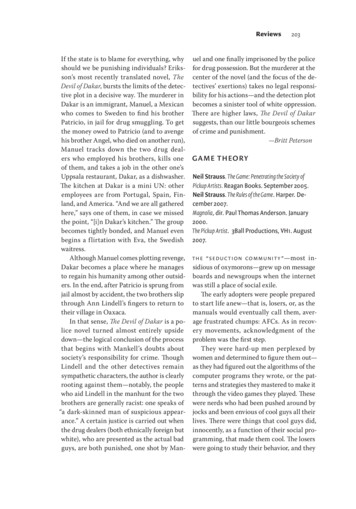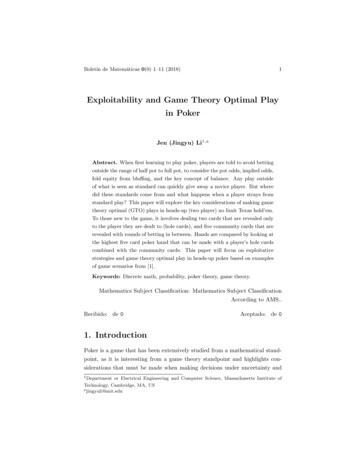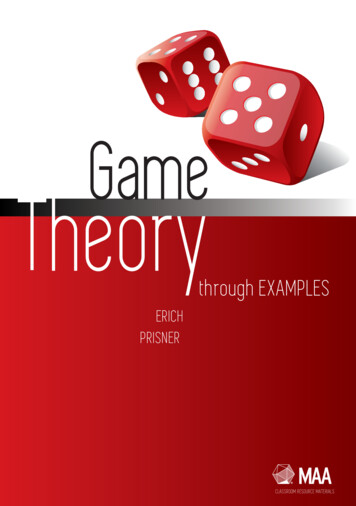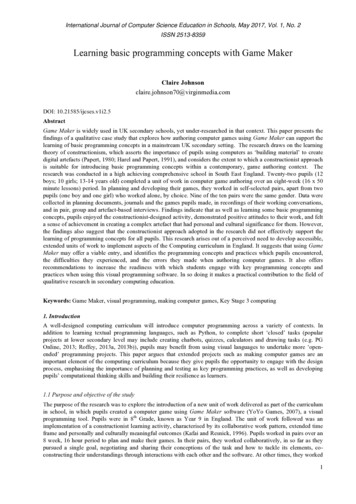
Transcription
ReviewsIf the state is to blame for everything, whyshould we be punishing individuals? Eriksson’s most recently translated novel, TheDevil of Dakar, bursts the limits of the detective plot in a decisive way. The murderer inDakar is an immigrant, Manuel, a Mexicanwho comes to Sweden to find his brotherPatricio, in jail for drug smuggling. To getthe money owed to Patricio (and to avengehis brother Angel, who died on another run),Manuel tracks down the two drug dealers who employed his brothers, kills oneof them, and takes a job in the other one’sUppsala restaurant, Dakar, as a dishwasher.The kitchen at Dakar is a mini UN: otheremployees are from Portugal, Spain, Finland, and America. “And we are all gatheredhere,” says one of them, in case we missedthe point, “[i]n Dakar’s kitchen.” The groupbecomes tightly bonded, and Manuel evenbegins a flirtation with Eva, the Swedishwaitress.Although Manuel comes plotting revenge,Dakar becomes a place where he managesto regain his humanity among other outsiders. In the end, after Patricio is sprung fromjail almost by accident, the two brothers slipthrough Ann Lindell’s fingers to return totheir village in Oaxaca.In that sense, The Devil of Dakar is a police novel turned almost entirely upsidedown—the logical conclusion of the processthat begins with Mankell’s doubts aboutsociety’s responsibility for crime. ThoughLindell and the other detectives remainsympathetic characters, the author is clearlyrooting against them—notably, the peoplewho aid Lindell in the manhunt for the twobrothers are generally racist: one speaks of“a dark-skinned man of suspicious appearance.” A certain justice is carried out whenthe drug dealers (both ethnically foreign butwhite), who are presented as the actual badguys, are both punished, one shot by Man-203uel and one finally imprisoned by the policefor drug possession. But the murderer at thecenter of the novel (and the focus of the detectives’ exertions) takes no legal responsibility for his actions—and the detection plotbecomes a sinister tool of white oppression.There are higher laws, The Devil of Dakarsuggests, than our little bourgeois schemesof crime and punishment.—Britt Petersongame theoryNeil Strauss. The Game: Penetrating the Society ofPickup Artists. Reagan Books. September 2005.Neil Strauss. The Rules of the Game. Harper. December 2007.Magnolia, dir. Paul Thomas Anderson. January2000.The Pickup Artist. 3Ball Productions, VH1. August2007.The “seduc tion communit y” —most insidious of oxymorons—grew up on messageboards and newsgroups when the internetwas still a place of social exile.The early adopters were people preparedto start life anew—that is, losers, or, as themanuals would eventually call them, average frustrated chumps: AFCs. As in recovery movements, acknowledgment of theproblem was the first step.They were hard-up men perplexed bywomen and determined to figure them out—as they had figured out the algorithms of thecomputer programs they wrote, or the patterns and strategies they mastered to make itthrough the video games they played. Thesewere nerds who had been pushed around byjocks and been envious of cool guys all theirlives. There were things that cool guys did,innocently, as a function of their social programming, that made them cool. The loserswere going to study their behavior, and they
204Reviewswere going to start replicating it. And oncethey were done with the process of breakingdown what the successful behaviors wereand why they worked, and once they weredone rewiring their own brains (which arefar more plastic, the neurologists tell us,than we have ever imagined), they wouldfind they could react in new ways to theold, scary stimuli—ways even more effective than those of their persecutors. In fact,because they were taking a methodical approach to what others did only by instinct,and because they had an analytic understanding of what others did in an unpremeditated way, they were going to be betterat being cool guys than any truly cool guycould ever be.They renamed each other, taking on talismanic handles, each of which declared ahope. Mystery. Extramask. Juggler. Playboy.Sin. Lovedrop. Matador. At sites like alt.fast.seduction.com, men from around the worldposted detailed narrative accounts of theirdates, soliciting, offering, and receivingcritical dissection of every statement andgesture. The men volunteered their experiences as data in a vast scientific trial that noresponsible researcher would ever attempt.You could even say that these men were engaged in a strange parody of the activitiesof the men of the Enlightenment, who usedthe printing press to diffuse a new attitudetoward life that broke with the inherited traditions and dogmas of the past. It was a freeand open exchange of ideas across international borders in which men distilled thechaos of experience into universal principles. Together they created a body of knowledge that was rational, pragmatic, purposive,and—above all—subject to the test of experiment.By means of the collective efforts ofhundreds of recovering AFCs and aspiringPUAs (pickup artists, in the literature), theywere able to observe, tag, categorize, anddevise a winning response to every twitch,flutter, or hesitation that a woman might offer in the progress, as their eventual leaderMystery would flatly put it, “from meet—tosex.” If a subject looked back at all his successful sexual encounters, he would see thateach and every one of them passed througha sequence of three stages. Mystery definedthese as attraction, building comfort, andseduction. By detaching oneself from thewelter of passions that afflict us in our everyday behaviors, one could arrive at a methodto move through those stages, consciously,and with maximum efficiency.All of us who have tried and failed tobreak through to the opposite sex thinkabout what works and what doesn’t whenit comes to the entirely unnatural sociability one must learn to master in a city full ofstrangers. The internet created a new spaceto transform that blind empirical gropinginto what would become, in the hands of itsmost gifted practitioners, a positivistic system of human relations.We have a record, of sorts, of what theworld of the pickup arts used to be like. TomCruise is the medium, in the role of FrankTJ Mackey, in Magnolia. Mackey opens hisclass by slowly flexing his biceps beneath abrightening spotlight on a darkened stageof a rented hotel conference room. Richard Strauss’s Also sprach Zarathustra blaststhrough the speakers.“Respect the cock!” Cruise shouts, tothe answering cries and bellows, hoots andchanting of his audience, “and”—and withthis he launches himself to the lip of thestage, revealing his chiseled face to the camera, kneeling with his arm outstretched ina gesture of embattled striving—“tame thecunt!”
ReviewsHis students are beefy rage-filled mooksin pleated Dockers. They work themselvesinto a frenzy at every cue, including themoment in Cruise’s presentation when hefeigns the act of intercourse—intercoursefrom behind—onstage. They learn how to,as the overhead projections tell them “FakeLike You Are a Nice and Caring Guy.” Theyare instructed to “Form a Tragedy,” as atechnique for earning sympathy, all in service of turning “Your ‘Friend’ into a ‘SpermReceptacle.’ ”Cruise’s portrayal was a cartoon thatnonetheless captured something about thestate of the pickup artists in their early days.The pioneering figure of the online seduction community was a man named Ross Jeffries, whom the music writer Neil Strauss,in his immersive account of the PUA worldtitled The Game, describes as a “tall, skinny,porous-faced self-proclaimed nerd.” Jeffries’searly e-books, which relied on a pseudohypnotic technique called neuro-linguisticprogramming (which instructs its would-bepractitioners to “seed” conversation withsubtly hidden commands that will act on thesubconscious of the recipient), were crudelywritten and full of sarcasm, resentment, andrage. His e-books were distinguished by thetypographical quirkiness, tonal crudeness,and brash salesmanship common to thework of autodidactic experts. Jeffries claimsthat Frank TJ Mackey was based on him.Though Jeffries certainly looks nothing likeTom Cruise (Strauss quotes Cruise denyingthat his character was based on Jefferies) theclaim was an entirely plausible one.“There’s no such ‘thing’ as love. There’s nosuch ‘thing’ as passion. There’s no such ‘thing’as attraction, or chemistry, or lust,” Jeffrieswrote in one of his early manuals.I know, I know, you’re saying. That’sthe problem . for most of you, most205of the time, there’s no such thing.There’s just boredom, frustration,and playing with Mr. Winky. Butthat’s not what I’m talking about, sopay close attention.I’m not saying that people don’t experience *states* of ‘attraction’ or‘chemistry’ or ‘lust’. What I am saying is that these states are processesthat take place inside the humanmind and body. Which means thatthey are states that .CAN BE SUMMONED FORTHAND DIRECTED AT WILL!!!Neil S tr auss le arned about this community just as it was beginning to make itstransition from being the obsession of a fewweirdos to a flourishing commercial venturefor many weirdos. He was handed a copy ofone of the first “Layguides,” and venturedonto the message boards as a reporter researching a story. It didn’t take long for himto lose his reportorial detachment. Soon hewas stuffing 500 cash into an envelope addressed to Mystery. Strauss overcomes thereader’s skepticism with the same élan withwhich he learned to “blast last-minute resistance,” conceding, with disarming candor,that it is “no easy feat to sign up for a workshop dedicated to picking up women. To doso is to acknowledge defeat, inferiority andinadequacy. It is to finally admit to yourselfthat all these years of being sexually active(or at least sexually cognizant) you have notgrown up and figured it out.”By the time Strauss arrived on the scene,the pickup artists had already begun to cleanup their act. The documents they wrote werebecoming more professional in their styleand presentation, the theoretical framework
206Reviewshad grown more sophisticated. The expertshad begun to scrub away the resentment andraw misogyny adhering to the community’srhetoric. Accordingly, a new kind of studententered the community: good-looking, successful, and competent men who were looking to make their sex lives less like gamblingand more like shopping. These men had other aspects of their lives working; now theywanted to “solve” the woman problem.Strauss was present at the first seminar,run by Mystery, at which students actuallyleft the classroom to go “in field.” Mysterybegan by explaining the basic structure ofseduction—FMAC, for find, meet, attract,and close. He explained the power of themysterious “neg,” one of the great innovations of the seduction community. Straussdescribes it thus:Neither compliment nor insult, aneg is something in between—an accidental insult or backhanded compliment. The purpose of the neg is tolower a woman’s self-esteem whileactively displaying a lack of interestin her—by telling her she has lipstickon her teeth, for example, or offeringher a piece of gum after she speaks.“I don’t alienate ugly girls,” Mystery explains.“I don’t alienate guys. I only alienate the girlsI want to fuck.”Armies of outlandishly dressed men(done up in accordance with “peacock theory”) began appearing in bars around thecountry. “Did you see those two girls fighting outside?” they would ask their targets,delivering the same canned material timeand time again. They would come in withtheir bodies at an angle and give the appearance of being ready to leave at any moment. “I can’t stay long—I’ve got to get backto my friends,” they would say, delivering
Reviewsthe “false time constraint” that preemptsany social discomfort their entrance intothe “set” would generate. With their first entrance, they’d “buy the next thirty seconds,”and with the story they told, they’d buy thenext two minutes, while “demonstratinghigher value” through precisely calibratedroutines. “I need a quick female opinion onsomething,” they’d begin, and then launchinto a story. “Would you let your boyfriendkeep a box of photos of his ex-girlfriend?Because my buddy . . . ” They’d talk to the“obstacles” (the ugly girls surrounding thetarget) and the men in the set, conspicuously ignoring the target. When she beganto clamor for their attention, they’d throwout a neg. “I like your nails. Are they real?”Strauss carried around, in his seduction kit,a large ball of lint that he would pick off agirl’s sweater. (Strauss eventually receivedhistorical confirmation of the value of theneg when he learned that Warren Beattywould blow his nose and hand the crumpledtissue to a woman.) Then the men would reverse course, give the target an opportunityto demonstrate her higher value, and playpush-pull, like dancing a string around fora cat to chase. Once you have reached the“hook point,” when she stops wonderingwhen you’re going to leave and begins looking for ways to make you stay, then it’s timeto propose an “instant date”—“bounce” toanother club, party, or diner, to embed theimpression of familiarity that movementfrom one location to the next will generatein her mind. “Every location that you movewith her in which she doesn’t wind up rapedand murdered by you,” Mystery observes,“builds comfort.” And when it comes downto last-minute resistance—which is a perfectly natural feature of her primal cognitiveprogramming—she’ll ask herself “Do I knowthis guy?” and have a panorama of images ofyou in different settings to refer to.207With the rise of “in field” training on theMystery model, the emphasis on esoterictechniques (such as Jeffries’s neuro-linguistic programming) for controlling the behavior of women fell away. The new pickup artistwas fun and positive. He had empathy with awoman’s feminine needs, and was willing toremake himself into the kind of man able tofulfill those needs. Not the things she saysshe wants, or even the
Neil Strauss. The Rules of the Game. Harper. De-cember 2007. Magnolia, dir. Paul Thomas Anderson. January 2000. The Pickup Artist. 3Ball Productions, VH1. August 2007. The “seduction community”—most in-sidious of oxymorons—grew up on message boards and newsgroups when the internet was still a place of social exile. The early adopters were people prepared to start life











